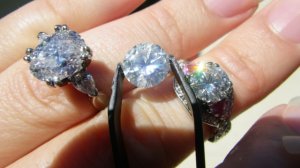- Joined
- Jun 27, 2011
- Messages
- 6
I have read a lot about strong fluorescence in diamonds giving a milky or cloudy appearance to diamonds, but I think often a simply cloudy diamond gets mistaken for being highly fluorescent. I included a photo of a Round Brilliant diamond that looks good in most lighting, however very milky/hazy in jewelry store spot lighting or direct sunlight. It rates a 1.3 on HCA and is an SI2 in clarity, but lacks transparency most likely do to pin point inclusions scattered throughout... Therefore giving in a lifeless dull look in certain light. My first impression was that it was an overly fluorescent stone but actually shoes no long wave or short wave fluorescence. (I'm a fan of blue fluorescence in diamonds- You can see in this photo that the strong blue fluorescence of my oval doesn't impair the transparency of the diamond in sunlight)
The center diamonds in the photos are a follows: 2.65 Oval (F color) with strong blue fluorescence, 2.31 Rd (H color) No fluorescence, 1.35 Rd (G color) No fluorescence.

The center diamonds in the photos are a follows: 2.65 Oval (F color) with strong blue fluorescence, 2.31 Rd (H color) No fluorescence, 1.35 Rd (G color) No fluorescence.








300x240.png)